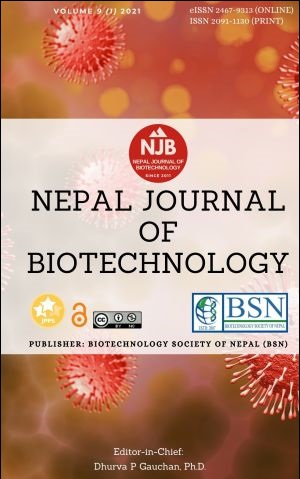Thyroid Function and Thyroglobulin Level in Iodine-Deficient Children of Eastern Nepal
DOI:
https://doi.org/10.3126/njb.v9i1.38670Keywords:
Children, Iodine deficiency, Nepal, Thyroid dysfunction, Urinary iodine concentration (UIC)Abstract
Iodine deficiency during childhood affects physical and mental development. Iodine deficiency or excess both can negatively impact thyroid function. We conducted this study to assess iodine nutrition and thyroid function in children with insufficient urinary iodine concentration. A community-based cross-sectional study was conducted among the selected schools of Udayapur district. Urinary iodine concentration (UIC) was measured in 1012 school children (6-14 years). Based on UIC data, 83 blood samples were collected to measure serum thyroglobulin (Tg), thyroid-stimulating hormone (TSH), free triiodothyronine (fT3), and free thyroxine (fT4). UIC was measured by ammonium persulfate digestion method, and Tg, TSH, fT4, and fT3 were measured using ELISA kits. The median UIE was 236 µg/L, and 11.1% of the children had insufficient UIC. The mean fT3, fT4, and TSH in children with insufficient UIC were 2.55±0.43 pg/mL, 0.96±0.28 ng/dL, and 3.60±1.44 mIU/L respectively. Among children with low UIC levels, the median Tg was 17.5 ng/mL. Overt hypothyroidism was seen in 6%, and subclinical hypothyroidism in 3.6%. The children had sufficient iodine nutrition, and the frequency of thyroid dysfunction was low among the children with insufficient UIC.
Downloads
Downloads
Published
How to Cite
Issue
Section
License
Copyright (c) 2021 Biotechnology Society of Nepal

This work is licensed under a Creative Commons Attribution-NonCommercial 4.0 International License.
Copyright Notice:
The manuscript submitted to NJB must be an original contribution, not previously published and should not be under consideration for publication elsewhere. When the manuscript is accepted for publication, the authors agree to automatically transfer the copyright of the article to the publisher. It should grant permission to any third party, in advance and in perpetuity, the right to use, reproduce or disseminate your article, according to the NJB copyright and license agreement.
Authors transfer copyright to the publisher as part of a journal publishing agreement but have the rights to: Share their article for Personal Use, Internal Institutional Use and Scholarly Sharing purposes, with the NJB applies the Creative Commons Attribution-NonCommercial CC BY-NC license to all the works we publish after Jun 2020 (Before it was CC BY-NC-ND). Under this license, authors agree to make articles legally available for reuse, without permission or fees, for virtually any non-commercial purpose. Anyone may remix, adapt, and build upon your work non-commercially, and although their new works must also acknowledge you and be non-commercial, they don’t have to license their derivative works on the same terms. More details on CC BY-NC refer to its Licence Deed and Legal Code.






